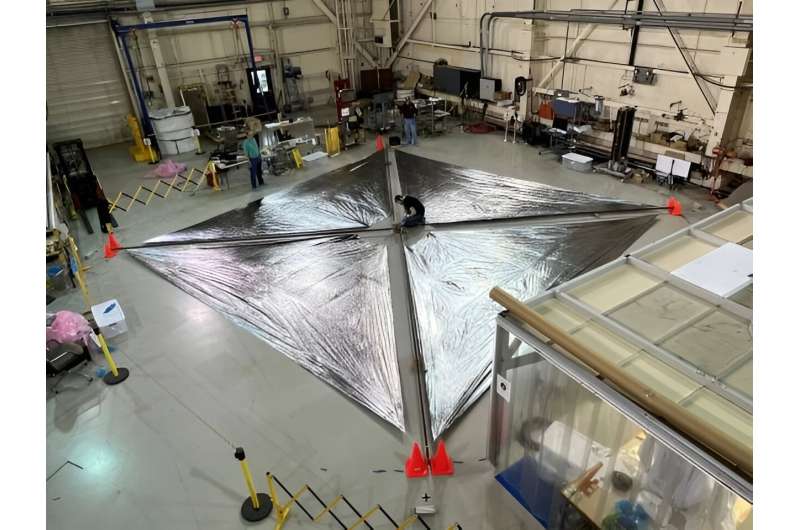This article has been reviewed according to Science X's editorial process and policies. Editors have highlighted the following attributes while ensuring the content's credibility:
fact-checked
trusted source
proofread
NASA's new solar sail extends its booms and sets sail

Solar sails are an exciting way to travel through the solar system because they get their propulsion from the sun. NASA has developed several solar sails, and their newest, the Advanced Composite Solar Sail System (or ACS3), launched a few months ago into low Earth orbit.
After testing, NASA reported on August 29 that they extended the booms, deploying its 80-square-meter (860 square feet) solar sail. They'll now use the sail to raise and lower the spacecraft's orbit, learning more about solar sailing.
"The sun will continue burning for billions of years, so we have a limitless source of propulsion. Instead of launching massive fuel tanks for future missions, we can launch larger sails that use 'fuel' already available," said Alan Rhodes, the mission's lead systems engineer at NASA's Ames Research Center, earlier this year.
"We will demonstrate a system that uses this abundant resource to take those next giant steps in exploration and science."
And for all you skywatchers out there, NASA said that given the reflectivity of the large sail and its position in orbit (about 1,000 km/600 miles) above Earth, ACS3 should be easily visible at times in the night sky.
The Heavens Above website already has ACS3 listed on their page (just put in your location to see when to catch the solar sail passing over your area.) There should be info and updates available on social media, so follow NASA.gov and @NASAAmes on X and Instagram for updates.
ACS3 is part of NASA's Small Spacecraft Technology program, which has the objective of deploying small missions that demonstrate unique capabilities rapidly. ACS3 launched in April 2024 aboard Rocket Lab's Electron rocket from New Zealand.
The spacecraft is a twelve-unit (12U) CubeSat built by NanoAvionics that's about the size of a microwave oven. The biggest challenge is designing and creating lightweight booms that could be small enough to fit inside the spacecraft while being able to extend to about 9 meters (30 ft) per side, and being strong enough to support the solar sail.
The lightweight but strong composite carbon fiber boom system unrolled from the spacecraft to form rigid tubes that support the ultra-thin, reflective polymer sail.
When fully deployed, the sail forms a square that is about half the size of a tennis court. To change direction, the spacecraft angles its sails. Now with the boom deployment, the ACS3 team will perform maneuvers with the spacecraft, angling the sails and to change the spacecraft's orbit.
The primary goal of the mission was to demonstrate boom deployment. With that now successfully achieved, the ACS3 team also hopes the mission will prove that their solar sail spacecraft can actually work for future solar sail-equipped science and exploration missions?
Since ACS3 is a demonstration mission, the goal is to build larger sails that can generate more thrust. With these unique composite carbon fiber booms, the ACS3 system has the potential to support sails as large as 2,000 square meters, or about 21,500 square feet, or about half the area of a soccer field.
"The hope is that the new technologies verified on this spacecraft will inspire others to use them in ways we haven't even considered," Rhodes said.
And look for photos of the ACS3 fully deployed sail next week. The spacecraft has four cameras which capture a panoramic view of the reflective sail and supporting composite booms. NASA said that high-resolution imagery from these cameras will be available on Wednesday, Sept. 4.
NASA is providing updates on this mission on their Small Satellite Missions blog page.
Provided by Universe Today





















